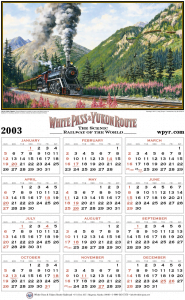GLACIER VALLEY THUNDER
16″x27″ oil-on-canvas
© 2002 J. Craig Thorpe, commissioned by the White Pass & Yukon Route
It is my distinct pleasure to once again work with the WP&YR to produce a piece of art celebrating this unique railway. The setting and composition for Glacier Valley Thunder actually evolved quite rapidly. Marketing Director Michael Brandt began our discussions by requesting that the piece focus on locomotive 73, which will have more visibility in the 2003 season. We discussed a variety of settings along the line, but decided upon this spot which looks across Glacier Valley and up at the expanse of Tunnel Mountain with a second train crossing the unique timber trestle. This point of view contrasts and compliments one of my earlier paintings which features the GE shovel-nose diesels and looks across the valley from Rocky Point and down to a second train beginning its ascent.
I have ridden the White Pass several times and had reference photos of the tunnel entrance and bridge taken from basically the same location as this painting. However, I did not have any photos or sketches of the mountain formations to the left of the tunnel. Because we wanted to show the 73 working upgrade I knew those distant mountains were essential. After describing what shots I needed, Michael hopped the next train out of Skagway armed with a digital camera. By printing out and splicing together the images, I had exactly what was needed.
Without distorting the reality of the scene, I slightly compressed the landscape in order to capture the various dramatic forms, colors and textures. I produced an initial pencil sketch to locate the essential compositional elements and after that was approved, transferred the image to canvas and roughed in the color. We had originally considered the painting to reflect the yellows of early autumn, but I soon felt that the brilliant fuchsia of the mid-summer fireweed, which grows along the right-of-way, would add to the richness of the piece. Further, the character of the fireweed worked with the vertical lines of the fir trees to not only contrast the essential horizontal composition, but more importantly lead the viewer’s eye up to the mass of the mountains and the second train. The addition of a bald eagle, just below the bridge, adds a touch of Alaska wildness to the composition.
The 73 is working hard on the grade, but the column of smoke and whisps of steam suggest that speed isn’t critical here. What is essential is the passengers’ contact with the wilderness. One of the constant themes of my rail art is that trains are not the nemesis of landscape. Indeed, they have been seen as “companions of the mountains.” This phrase comes from Northern Pacific Railway ads produced in the 1930s featuring the art of Gustav Krollmann. It is my intent to tell our culture, through the evocative medium of paint, that there is an alternative to asphalt. Trains are not simply the stuff of nostalgia, as wonderful as that is; they are critical for the stewardship of our landscapes and cityscapes today. Further, passenger trains enable community, as passengers — together — experience the majesty of seacoast, prairie, and in this case the Alaska-Yukon wilderness. These paintings, then, are not just train or locomotive portraits. They are “landscapes of expectation” which invite the viewer into captivating settings on a form of transport crucial to the preservation of our national landscapes and even civility itself.
My thanks to the White Pass & Yukon for this opportunity to once again paint the captivating story of steel wheels on steel rails.
Click here to download the calender in pdf format. Or click the image to view the calendar in your browser.
